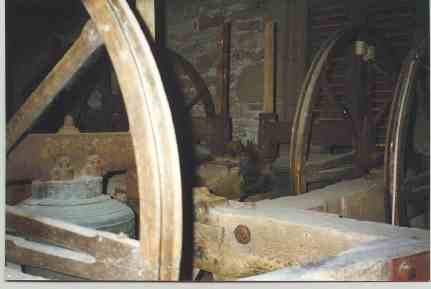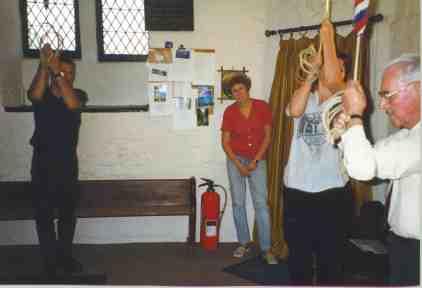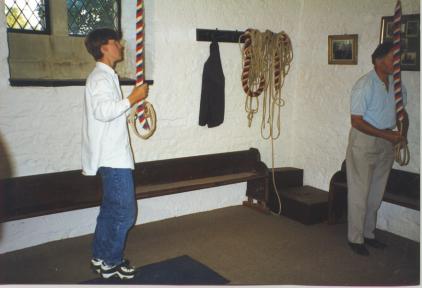| Pre-Roman | Roman | Dark Ages | Domesday Book | Medieval | Civil War | Industrial Revolution |
Victorian | Modern | Timeline | |
| |
Home | What's New | A-Z Index | People Index | Links | Genealogy | Church | Maps | Site Search | Sources |
(Kempsey Collection (1984), pages 53-7)
"RING OUT THE WILD BELLS": On the second floor of the church tower is the ringing chamber where the ringers stand to pull the ropes and ring the bells. In one corner is quite a large clock case containing the remains of the mechanism of an old clock which struck the hours on one of the bells. According to the records of 1640 "2d. was paid for sallet oyle for the clocks". Although it was repaired in 1812 it is believed to have fallen into disuse over 100 years ago.
The room above is the bell chamber which contains a ring of six bells and the sanctus bell. Some bells must have been installed soon after the tower was completed, for as early as 1535 John Rushmere, in his will left 3s. 4d. for repairing Kempsey Church bells.
In 1552 the Church Inventory recorded four bells, one sanctus bell, two handbells; and in 1578 the churchwardens' accounts showed 12d. paid for mending four bells and 22d. for bell-ropes. In 1685 the sum of 3s. 0d. was paid "for ringing of the church bells to celebrate the defeat of the Duke of Monmouth at the Battle of Sedgemoor on 6th July."
It appears that these old bells were melted down and re-cast to form the present ring by the firm of Bagley, whose foundry was at Chacombe in Northamptonshire. the front five bells bear the date 1686, but the sixth (tenor) was cast by T. Mears in 1821, so probably the tenor was cracked and re-cast then. Each bell carries an inscription which is as follows :
1. CANTATE DOMINO CANTICVM NOVVM. 1686
2. FEARE GOD AND HONOVR THE KING. 1686
3. MATTHEW BAGLEY MADE MEE. 1686
4. HENRICVS BAGLEY ME FECIT. 1686
5. WILLIAM WIGFALL AND WILLIAM IONS CHVRCH WARDENS.
1686
6. T. MEARS OF LONDON FECIT. 1821
 The tenor ( the largest bell ) weighs over 15 cwt., this being confirmed by
John Taylor & Co. The oldest bell is the sanctus, which was cast in 1587 by a
Gloucester founder known only by his initials I.B. The inscription on the bell reads
: T (fleur de lys) R (rose) K (fleur de lys) W (rose) I (fleur de lys) L1587 I (bell) B.
The tenor ( the largest bell ) weighs over 15 cwt., this being confirmed by
John Taylor & Co. The oldest bell is the sanctus, which was cast in 1587 by a
Gloucester founder known only by his initials I.B. The inscription on the bell reads
: T (fleur de lys) R (rose) K (fleur de lys) W (rose) I (fleur de lys) L1587 I (bell) B.
An epitaph on a wooden board to a bellringer named Stephen White who died on 21
November 1811 aged 85, used to hang in the chamber; it read:
"Time and Stephen are now both even,
Stephen beat time and now time beats Stephen."
There must have been an active band of ringers in the 1890s as the Kempsey Church monthly says that the choir and bellringers' outing on Monday 17 July 1893 was to Scarborough. The party of 40 left Shrub Hill station at midnight on 16 July, arriving at Scarborough at 7 am, and left at 6.30 pm. Kempsey was reached at 2.30 am Tuesday. "The outing, although fatiguing was in every way a decided success."
At this time the man in charge of the ringing was Francis Anson (Frank) Rea who became the "grand old man" of Kempsey (see "Kempsey's Oldest Inhabitant"). In the 1920s the bells had become difficult to ring, so in 1928 they were over-hauled and re-hung on ball-bearings by John Taylor & Co. of Loughborough. They are still in good order today, and are one of the best rings of six in Worcestershire.
Early in 1932 the old ringers had left and in May a new band was formed by Walter Curtis. This saw the introduction to change-ringing to Kempsey. Previously the bells had been rung to "Call Changes" i.e. changes in the order in which the bells ring, each change being repeated until the conductor calls another one. The new band decided to learn "change-ringing" i.e. a system of ringing which causes a different change to be rung at each pull of the rope. With that object in mind they joined the Worcestershire and Districts Association of Change Ringers, and a Worcester ringer, John J. Jefferies, instructed them in this art. Quite rapid progress was made, and on 23 December 1933 a peal was rung - a peal being at least 5,000 changes rung without pause.
Another unique peal was rung the following year. It was rung by three fathers and three sons, and all were local Sunday service ringers at Kempsey church. Many more peals have been rung since. The fourth father and son members of that early band were I and Arthur I. Blizard, and six of them were related to Frank Rea: H. Compton (step-brother), W. Compton (nephew), F.J. Cubberley (son-in-law), E.F. Cubberley (grandson) F.A. Rea (grandson) and R.W. Rea (grandson).
The bells continued to ring out regularly until 1940, when a ban was placed on all ringing. The only time the bells could be rung was as a warning in the event of an invasion. The Home Guard used the tower as a "look-out" post for such an eventuality. Fortunately it was never necessary to give any warning, and the bells were allowed to ring to celebrate the victory of El Alamein in 1943.
Subsequently the ban was lifted altogether , and bell ringing has continued regularly ever since. The bells are rung for both joyous and sad occasions. They ring out loud and clear normally, but to mark the sad occasions they are rung half-muffled, i.e. a leather pad is attached to one side of the clapper, which strikes the bell, to deaden the sound, so that there is one loud note and then a quiet one.
In Kempsey the ancient tradition of ringing out the Old Year and ringing in the New is observed. The bells are rung half-muffled before midnight on 31 December to signify the Old Year is dying, and then the muffles are removed and as 12 o'clock strikes the bells ring out loud and clear to welcome the New Year. Half-muffled ringing also takes place every year on Armistice Sunday.
| Bell Ringers in 1998 | |
 |
 |
| Left to right: Paul Smith, Jeanne Folkes Rachel Stanyer and Ernest Cubberley (Master Bellringer) | Left to right: Paul Mills and Henry Morris (Church Treasurer) |
Ringers come and go for a variety of reasons, but fortunately Kempsey has always had sufficient numbers of ringers to keep the bells swinging. Two of the band who were taught to ring in 1932 are still ringing here today. Arthur Blizard and myself have each completed 52 year's service, and the other members Henry Morris, William Halford, Mrs. Murial Burgham, Jim Wallace and Michael Harrison have all been ringing for many years.
E.F. Cubberley
"SUMMONED BY BELLS" : The distinguishing feature of the English handbell is the hinging of the clapper to swing in only one plane and it responds only to movements of the hand and wrist in that plane. This means that skilled ringers can take two bells in each hand with their striking planes at right angles to each other and by the correct movements of each hand can sound the four bells separately in any order or as part of a musical scale.
The art of tune ringing on handbells seems to have begun in the 17th century when they began to be used as part of the bell tower equipment. Their purpose was for the practising of change ringing - less strenuous and noisy than using the the tower bells - and the ringers were also able to play hymn tunes. At Christmas they played carols outside the village inns and were suitably rewarded. The rather Dickensian image we have of seasonal merrymaking, universal goodwill and free beer persists in many people's minds and television has not helped to change it. But at least in Kempsey, it is acknowledged that a team of ringers can create real and moving music in both cathedral and village hall.
Over the years more and more churches acquired handbells and tune ringing reached its peak about the turn of the century. Indeed we have a photograph of the Kempsey bells and their ringers, all men, posed against the south wall of the church tower. But interest in the art was waning; no doubt the Great War and social change were the main factors, the gramophone had arrived and "the Wireless" was on the way. However, interest in music making with handbells began to revive in the 1960s and that interest is today widespread, well supported and growing.
In 1975 a few of us became interested in handbell ringing and we were therefore very lucky to find St. Mary's set of 12 handbells still in the tower, and the Church Council gave us permission to use them. They needed renovation, and we raised the necessary £60 for Frank Barnett of Malvern to do the job. He also let us have a very useful 13th bell for £20. We made great progress with the 13 bells, but realised the limitations imposed on us by the small range of one octave; but in 1978 we were very lucky to get our own set, two chromatic octaves, and these bells have been put to very good use.
Over the years the team (which has remained largely unchanged) has travelled to many places and taken part in rallies and concerts throughout the country: we have played our bells in the Free Trade Hall, Manchester, the Colston Hall in Bristol and places in between. Worcester Cathedral is one of our favourites because the atmosphere of a great cathedral and the interest of visitors combine to provide a rewarding experience for us all.
It is no exaggeration to say that St. Mary's handbell team has built up a fine reputation and put the name of Kempsey on the map as far as the creation of real music is concerned. Meanwhile the church handbells have not been silent; they are being played by an enthusiastic team of young girls who have already delighted many people with their playing.
St. Mary's is led by Betty Bellhouse, who arranges all the music, and the team members are Audrey Cullis, Sheila Webster, Joan Watson, Sheila Anderson, Maureen Sutton, Cicely Barnes, Joy Dale, Edna Cope and Joan Harrison.
B. Bellhouse
Kempsey Handbell Team 2003
Joan Harrison, Sheila Webster, Vivienne Davis, Cicely Barnes, Joy Dale, Edna Cope, Sheila Anderson and Jill Price. Leader: Betty Bellhouse
Sanctus Bell
A bell, commonly placed in a ‘cote’ or turret at the junction of the nave and
the chancel (but often a handbell), rung at the Sanctus at Mass; in post-Reformation times
often used to summon the people to church, being rung immediately before the service, when
the pealing had ceased.
For more details see:
the page on the Church
the Purton manuscript on the history of the village, with a section on the church
the Victoria Country History of the parish, with a section on the church
 hits since 9th September 1999.
hits since 9th September 1999.